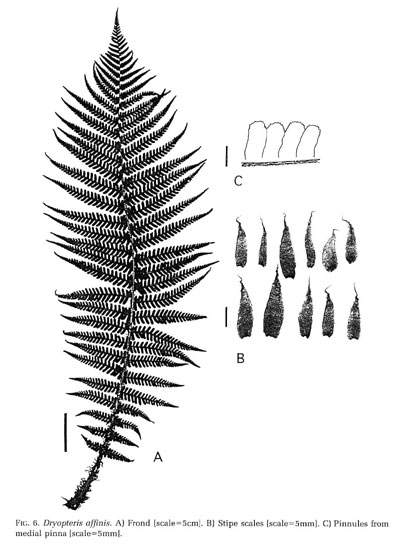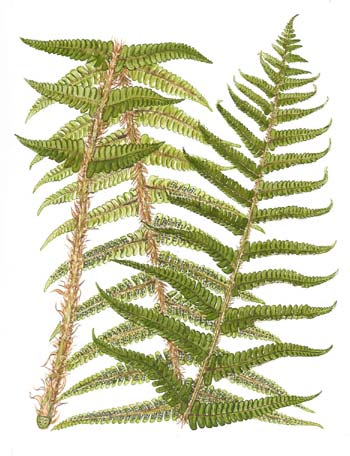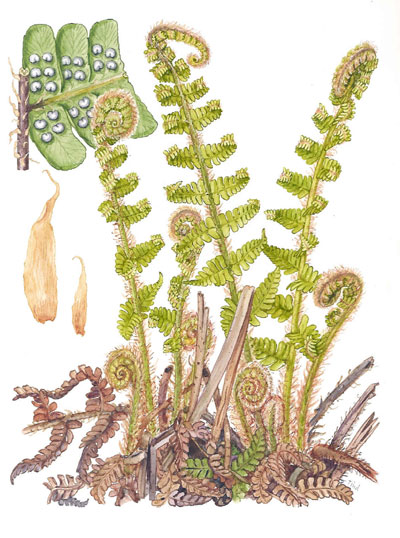| Dryopteris affinis | ||
Scaly male fern | ||
|
Etymology
affinis, Latin: neighboring or akin to, perhaps referring to similarity to the male fern, D. filix-mas
Description
Rhizome: erect, stout.
Frond: 100 cm high by 20 cm wide, deciduous early in colder areas, monomorphic, blade/stipe ratio: 4:1. Stipe: grooved, golden-brown, dense, conspicuous scales with a dark base, petering out only after the fourth or fifth set of pinnae, vascular bundles: 3-7 in a c-shaped pattern. Blade: 2-pinnate, lanceolate, usually tapering towards the base, leathery, lustrous, yellow-green, scales continue on underside of costa. Pinnae: 30 to 35 pair, subopposite on rachis, base with a dark blotch (diagnostic fresh, missing when dried); pinnules oblong, usually truncated at the apex; costae grooved above; segments oblong; margins somewhat crenate; veins free, forked. Sori: round, in 1 row between midrib and margin, indusium: doughnut-shaped, convex, steel-gray when young, aging to brown, at a sinus, sporangia: black, maturity: mid to late summer. Culture
Habitat: woods and shady places, open areas among rocks.
Distribution: Europe to Caspian to North Africa.
Hardy to -30°C, USDA Zone 4.
Distinctive Characteristics
dark blotch on the costa at its junction with rachis
Synonyms
Dryopteris pseudomas (Wollaston) Holub et Pouzar Dryopteris borreri Newm. Dryopteris abbreviata Newm. Lastrea abbreviata Woll. Nephrodium abbreviatum Lowe Polystichum abbreviatum Lam. & DC. |
|
|
Notes
Compare to D. filix-mas and D. oreades. C.N. Page writes "The more generally shining frond which is more yellow green on flushing, the denser, generally more golden-brown scales ..., the stiffer, more leathery frond texture, the narrow pinnae with usually more truncated segments, the laxer crozier when flushing, and the dark patch to the base of each pinna distinguish most specimens of all subspecies of D. affinis from both D. filix-mas and D. oreades, the only other species with which they are likely to be confused."
Progeny All D. affinis are apogamous, i.e., the offspring are identical to the parent plant, hence, no variation except for the occasional mutations that have given rise to all the cultivars.
ssp. borreri frond/stipe ratio 2:1, i.e., a longer stipe than ssp affinis, stipe scales straw to pale gray-brown rather than golden-brown. The dark blotch at the junction of rachis and costa is mentioned as true for the species, but shows up in none of the subspecies images above.
ssp. cambrensis blade longer, narrower, lower pinnae gradually shorter, the lowest half the middle, pinnules of uneven length, often twisted, often with margins folded down, scales reddish-golden, glossy, twisted on the upper stipe. This taxon may include parentage from D. oreades or D. caucasica or both.
Compare to D. filix-mas and D. oreades. C.N. Page writes "The more generally shining frond which is more yellow green on flushing, the denser, generally more golden-brown scales ..., the stiffer, more leathery frond texture, the narrow pinnae with usually more truncated segments, the laxer crozier when flushing, and the dark patch to the base of each pinna distinguish most specimens of all subspecies of D. affinis from both D. filix-mas and D. oreades, the only other species with which they are likely to be confused."
Progeny All D. affinis are apogamous, i.e., the offspring are identical to the parent plant, hence, no variation except for the occasional mutations that have given rise to all the cultivars.
ssp. borreri frond/stipe ratio 2:1, i.e., a longer stipe than ssp affinis, stipe scales straw to pale gray-brown rather than golden-brown. The dark blotch at the junction of rachis and costa is mentioned as true for the species, but shows up in none of the subspecies images above.
ssp. cambrensis blade longer, narrower, lower pinnae gradually shorter, the lowest half the middle, pinnules of uneven length, often twisted, often with margins folded down, scales reddish-golden, glossy, twisted on the upper stipe. This taxon may include parentage from D. oreades or D. caucasica or both.

Dryopteris affinis. Illustration from The Cultivated Species of the Fern Genus Dryopteris in the United States, Barbara Joe Hoshizaki and Kenneth A. Wilson, American Fern Journal, 89, 1, (1999), with permission. |

Dryopteris affinis. Frond. Illustration from Scandinavian Ferns by Benjamin Ĝllgaard and Kirsten Tind, Rhodos, 1993. |
